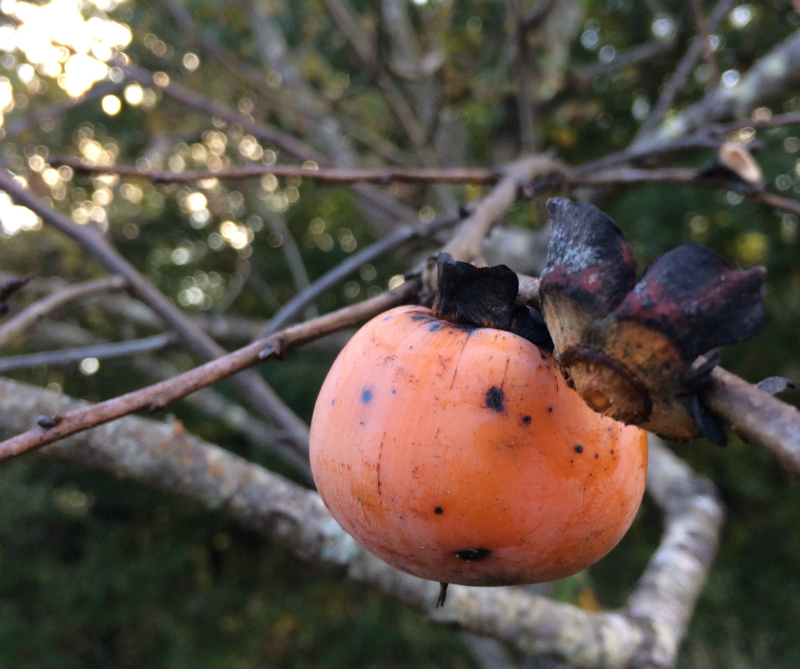
Autumn usually offers bucolic experiences such as apple picking and hunting for the finest jack-o’-lantern pumpkin, yet we’ve started a new tradition on our farm that I hope will help us ring in fall for years to come: harvesting persimmons.
Few people have heard of, let alone know what to do with, persimmons, which is a shame considering the persimmon is a native fruit. I must admit, I’m among the crowd that’s guilty of living life oblivious to the persimmon’s pleasures, but that ends now. The American persimmon (Diospyros virginiana) grows across much of the United States (you can also grow them yourself) and is extremely plentiful on our land—probably thanks to its soft fruits that drop to the ground in little pellets of mush that get lost in the pasture grass. The Latin name literally means “fruit of the gods,” owing to the fact that the ripe fruits are divinely sweet. How can you continue with life knowing that the fruit of the gods is growing in your backyard? You just can’t.
We have been blessed with what our neighbors refer to as the granddaddy of all persimmon trees. It’s a prominent tree on the landscape that, in years past, has provided more fruit to the landholders than one could ever eat, process and give away. However, one of several severe storms that swept across our area this summer knocked the middle portion of the tree straight down. The tree is still standing, but it now resembles more of a fork than a big, beautiful, granddaddy tree. It’s a shame, though I believe it will continue to produce fruit in the future. Fortunately, we have plenty of persimmon-tree children and grandchildren to make up the difference in fruit harvested.
We’re learning as we go when it comes to how to harvest and process persimmon fruit, though we’ve gleaned a few tips from some of our old-timer friends. Here are the main ones.
1. Beautiful Is Not Better

The first lesson you learn when collecting persimmons is that those beautiful, unblemished, orange fruits hanging prettily on the tree like ornaments are not for eating. No, it’s the brown, mushy fruits that look half-rotten on the ground that you’re after. Those ugly fruits are where the sweetness lives. Take a bite of the pretty fruit, and the involuntary pucker that crosses your lips will make it apparent why you need to wait a little longer before picking.
2. Use a Tarp
The persimmon-harvesting pros lay down tarps or hang up netting, olive-harvest style, to prevent the ripe fruits from getting squished into the dirt or becoming fare for local wildlife. I must admit, we haven’t employed this method yet—partially because I have my hands so full juggling a 1-year-old that getting out a tarp hinders the process, and partially because I don’t mind a little dirt on my fruit.
3. Shake the Tree
If you wait for your persimmons to fall to the ground naturally, you risk your harvest getting gobbled up by a host of wild creatures—deer, raccoons, foxes, you name it. We’ve found that, particularly with smaller trees, a gentle shaking encourages the ripe fruit to fall to the ground leaving those lip-puckering orange fruits in tact.
4. Get a Food Mill
Persimmons are covered with a delicate skin and contain many seeds within their tiny fruit bodies, so processing by hand like you might an apple is not efficient. Everyone told me that the best way to go is a food mill. While I usually jump at the chance to try a new kitchen gadget, I was leery of this one. Thankfully, a friend loaned us her food mill, and we learned how very easy it makes persimmon processing. I’ll add one to this year’s Christmas list and search for other ways to put it to use.
5. Freeze the Pulp
Eating a whole pasture’s worth of persimmons in the short time frame that the fruits come off the tree would be a practice in sheer insanity. Even if you made all the persimmon cookies, puddings, breads and jams you could manage, why not spread the love out over the entire year? We froze our pulp in quart-size containers, then scoop out the amount we need for a recipe. (It scoops easily, like ice cream.)
Bonus Tip: Predict Your Winter Weather

Once you’ve processed the pulp, crack open a few seeds and look at the kernel to find out what this winter’s weather has in store. Folklore says that if you find a fork, the winter will be mild; a knife, it will be frigid with “cutting” winds; and a spoon, you better have your snow shovel handy. As you can see from our seeds, we expect a good deal of snow.
Now that we have our freezer stocked with the 2018 persimmon harvest, I’m looking for new recipes to cook up this winter as we’re snowbound. Leave a comment below if you have one you recommend.




